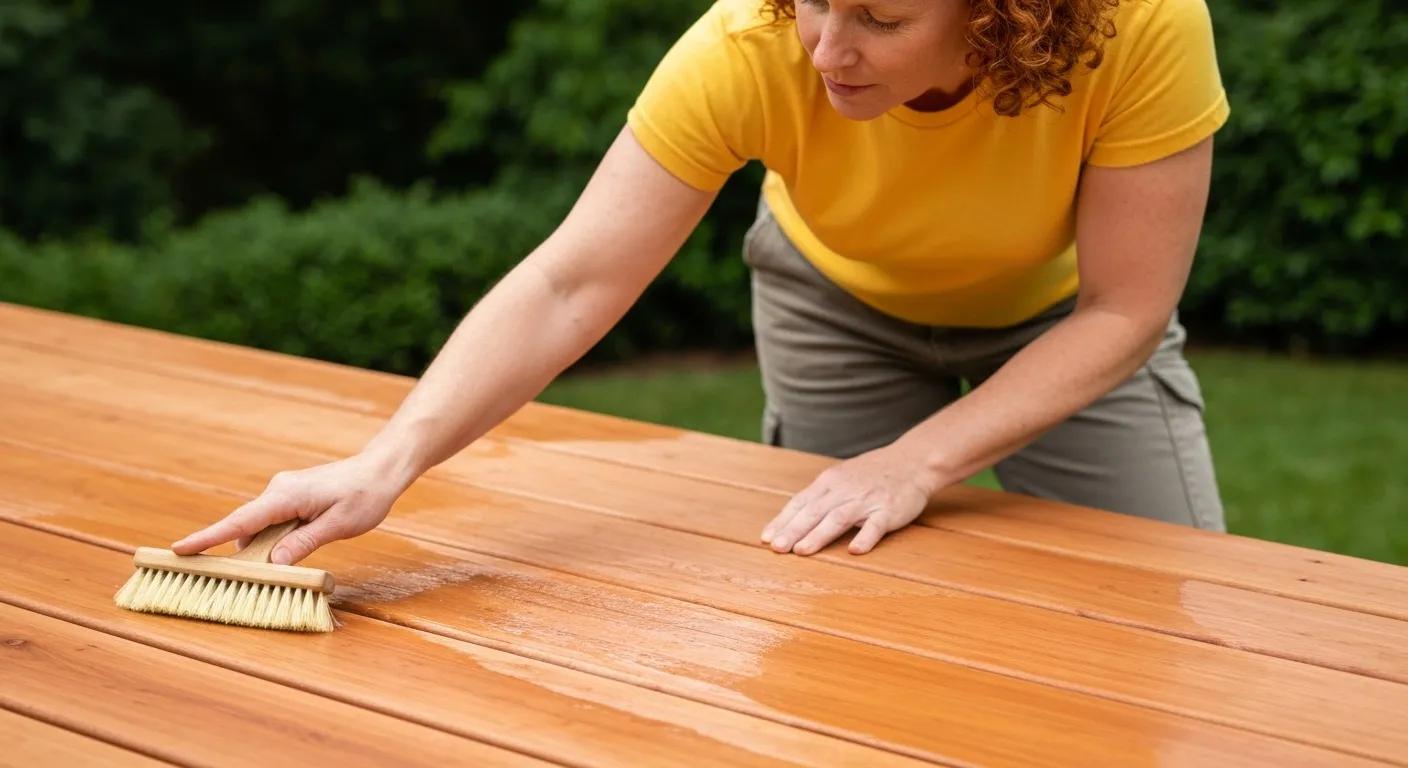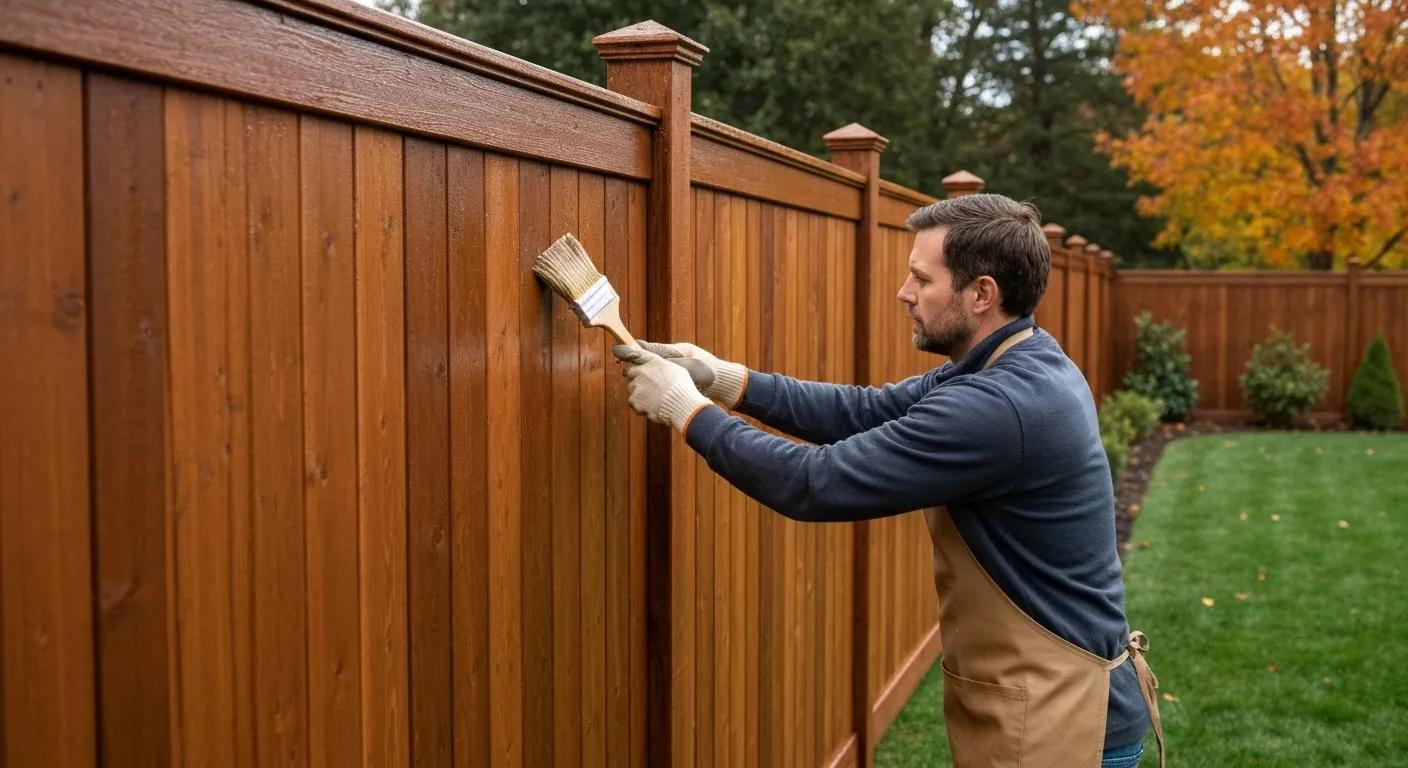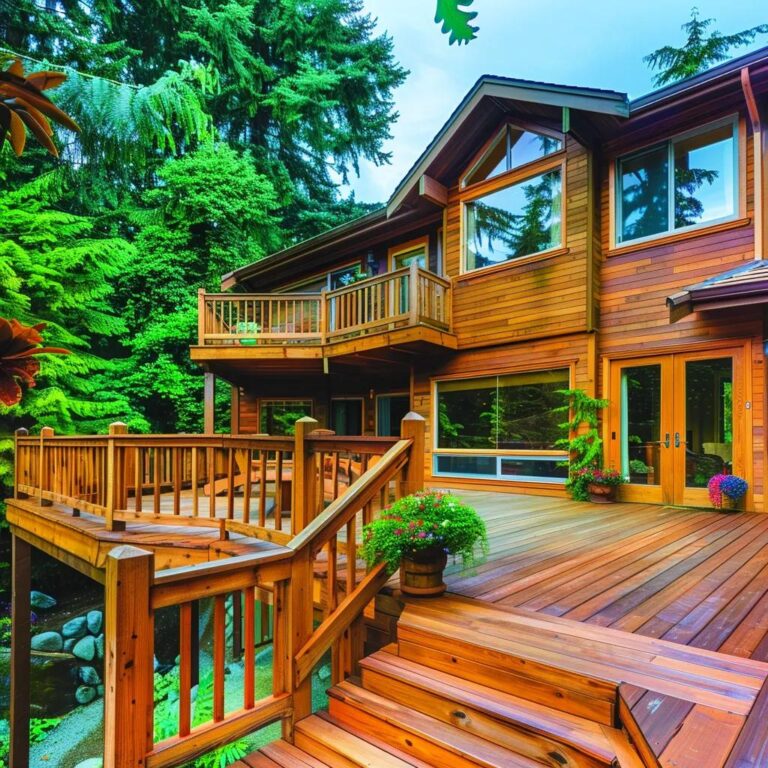Fall Cedar Care: Shield Your Wood Structures for Winter
Autumn presents a crucial window to fortify your cedar wood against moisture, mold, rot, and UV damage before the harsh winter elements arrive. Overlooking this essential fall upkeep can lead to expensive repairs and accelerated structural deterioration.
This guide offers homeowners and businesses expert strategies for the thorough fall care of their cedar decks, siding, fences, and roofs. We blend practical, step-by-step instructions with professional insights drawn from Timberseal’s specialized cedar preservation services.
Discover why fall maintenance is indispensable, learn effective deck cleaning techniques, explore optimal sealants and stains, master mold prevention, master siding and fence repair, utilize roof inspection checklists, and understand the cost-saving advantages—all designed to guide you toward requesting a quote for expert cedar protection.
Why is Fall Maintenance Essential for Cedar Wood Protection?
Fall maintenance is the seasonal process of preparing your cedar wood structures to withstand winter’s freeze-thaw cycles, moisture intrusion, and UV stress. Diligent autumn care prevents excessive water absorption and fungal growth, which are primary drivers of decay. Understanding the common winter damages that affect cedar highlights why timely maintenance is key to preserving its structural integrity and aesthetic appeal.
The Critical Importance of Fall Maintenance
Fall maintenance is paramount for safeguarding cedar wood against the damaging effects of winter, including freeze-thaw cycles, persistent moisture, and UV radiation, all of which can accelerate decay. Proper autumn care is vital for preventing water absorption and inhibiting fungal growth, thereby preserving the structural soundness and visual appeal of your cedar structures.
This esteemed source underscores the necessity of consistent inspections and upkeep to maximize the lifespan of cedar roofs, a principle that directly supports our focus on essential fall maintenance for all cedar structures.
What Winter Damages Can Affect Cedar Wood?
Cedar wood is susceptible to several hazards during winter, primarily related to freeze-thaw cycles and moisture exposure:
- Moisture Trapping: Rain and melting snow can saturate deck boards, siding planks, and fence rails, significantly increasing the risk of fungal proliferation.
- Freeze-Thaw Splitting: Water that becomes trapped within the wood fibers expands when it freezes, leading to the formation of cracks and surface checks.
- Mold and Mildew Proliferation: Persistent dampness creates an ideal environment for mold colonies to thrive, which can discolor the wood and degrade its natural protective oils.
- Rot and Decay: Prolonged exposure to moisture softens the wood, creating an entry point for wood-destroying fungi that can compromise the structural integrity of load-bearing components.
By proactively preventing these damages through thorough autumn cleaning and sealing, you establish a robust barrier against winter stresses and lay the groundwork for extending the service life of your cedar structures.
How Does Fall Maintenance Extend Cedar Wood Longevity?
Fall maintenance enhances the longevity of cedar wood by effectively sealing its fibers, eliminating decay-causing agents, and replenishing its protective oils. These combined actions significantly reduce moisture uptake and mitigate UV degradation.
- Surface Revitalization: Cleaning effectively removes organic debris that can trap moisture against the wood grain.
- Protective Coating Application: Sealants and stains create a barrier that locks out water and blocks UV rays, preventing the breakdown of lignin.
- Structural Repair Execution: Filling existing cracks and replacing compromised boards halts the progression of rot before winter sets in.
By integrating these essential steps, you ensure your cedar wood maintains its inherent strength and attractive appearance, preventing winter damage from becoming irreparable.
When is the Optimal Time for Fall Cedar Maintenance?
The ideal period for performing fall cedar maintenance is from late September through early November. This timeframe is specifically chosen for when daytime temperatures consistently remain below 70°F and before the onset of the first hard freeze.
- For Northern Climates: Aim to complete tasks between September 15th and October 15th to preempt early frosts.
- For Mid-Atlantic and Southern Regions: Schedule your maintenance between October 1st and November 1st to avoid periods of high humidity.
- Monitoring local weather forecasts is crucial to ensure that applied coatings have adequate time to cure fully before cold snaps occur.
Timing your autumn maintenance correctly ensures optimal sealant adhesion and guarantees that your cedar structures enter the winter season with complete protection.
How to Clean Cedar Decks Effectively in Fall?

Effective fall deck cleaning is essential for removing accumulated debris, biological growth, and surface contaminants that contribute to moisture retention and decay. This process creates a pristine substrate, perfectly prepared for sealing and staining as part of your winter preparation.
What Are the Best Techniques for Removing Debris and Mold from Cedar Decks?
Begin the cleaning process by gently removing organic matter and mold using mild agitation and targeted cleaning solutions.
- Utilize a soft-bristle broom to sweep away all leaves, pine needles, and loose debris.
- For areas prone to mold and mildew, scrub gently with a mixture of oxygen bleach and water (maintaining a 1:3 ratio) using a soft brush.
- Rinse the deck thoroughly with low-pressure water to prevent any risk of wood splintering.
- Allow the deck to air dry completely, which typically takes 24 to 48 hours, before proceeding with any sealing applications.
Meticulously removing debris and mold ensures that sealants will bond effectively and prevents the resurgence of fungal growth when moisture levels inevitably rise.
Which Cleaning Products Are Safe for Cedar Wood?
Cedar wood requires the use of gentle cleaning agents that effectively strip away grime without compromising the integrity of its fibers.
- Oxygen bleach solutions are highly effective at eliminating mold and mildew without the harshness associated with chlorine-based products.
- pH-neutral wood detergents are ideal for lifting dirt and organic stains without causing discoloration.
- Wood-safe mildewcides provide residual fungal control by actively inhibiting spore germination.
By selecting these appropriate products, you preserve the natural tannins within the cedar and prepare the surfaces for treatment without risking chemical damage.
How to Use Low-Pressure Washing and Soft Brushes on Cedar Decks?
Employing low-pressure washing in conjunction with manual agitation allows for a deep clean without causing brittleness in the cedar fibers.
- Set your pressure washer to a setting below 500 psi and maintain a nozzle distance of 12 to 18 inches from the wood surface.
- Work in manageable sections, approximately 4×4 feet, applying a mild detergent and rinsing immediately.
- Use a soft-bristle brush to scrub stubborn grime in areas where water alone may not be sufficient.
- Rinse away all cleaning residue and allow the boards to air dry completely before moving on to the sealing stages.
Combining controlled water pressure with gentle brushing techniques preserves the wood’s natural integrity and ensures an even finish for sealant application.
What Are the Best Sealants and Stains for Fall Cedar Deck Maintenance?
Selecting the appropriate finish for your fall cedar decks is crucial for sealing out moisture, preserving color, and ensuring resilience against winter conditions. Comparing the various stain and sealant options will help clarify your choice.
Choosing a finish that effectively balances UV protection, moisture resistance, and your desired aesthetic outcome will ensure your decks remain both durable and visually appealing throughout the winter months.
How to Choose Between Oil-Based, Water-Based, and Semi-Transparent Stains?
When staining decks in the fall, it’s important to select products specifically formulated for your climate, expected usage, and the desired level of opacity.
- Oil-Based stains are designed to penetrate deeply into the wood fibers, reinforcing the wood from within.
- Water-Based stains offer faster curing times and provide excellent resistance to mildew, particularly beneficial on humid days.
- Semi-Transparent finishes are excellent for showcasing the natural grain of the wood while providing a moderate level of UV defense.
Matching the product’s attributes to your specific site conditions will maximize protection and minimize the frequency of future maintenance.
What Are the Benefits of UV Protection and Water-Repellent Sealants?
Sealants containing UV inhibitors are crucial for filtering out harmful rays that can degrade lignin and lead to surface checking, while water-repellent sealants are essential for preventing moisture penetration.
- UV Blockers effectively combat color fading and protect against sun-induced splintering.
- Hydrophobic Agents significantly reduce capillary water uptake, thereby slowing down damage caused by freeze-thaw cycles.
- Dual-Action Formulas combine both protective functions, offering comprehensive shielding for cedar deck boards year-round.
These advanced protective properties are vital for maintaining the wood’s strength and minimizing the impact of winter weathering until spring maintenance can be performed.
What Are the Best Practices for Applying Sealants and Stains in Fall?
- Ensure you work on dry days with temperatures between 50°F and 70°F, and humidity below 70%.
- Lightly sand any weathered boards to open the wood pores, allowing for better absorption of the finish.
- Stir the product thoroughly before application and apply it using a natural-bristle brush, following the direction of the wood grain.
- Apply two thin coats rather than one thick coat to prevent unevenness and surface pooling.
- Allow the finish to cure completely before allowing foot traffic or placing furniture back on the deck.
Adhering to these best practices ensures uniform coverage and provides durable protection throughout the winter season.
How to Prevent Mold, Mildew, and Rot on Cedar Decks During Fall and Winter?
What Are the Signs of Mold and Mildew on Cedar Wood?
Mold and mildew often present visible and tactile indicators before they cause deep-seated damage:
- Dark Stains or Spots: These typically appear along board seams or in shaded areas where moisture lingers.
- Slippery Film: A slick surface underfoot after rain signifies the presence of a fungal film.
- Musty Odors: Distinctive musty smells emanating from the wood fibers indicate active fungal growth.
- Surface Softening: A slight softening of the wood surface when pressed with a fingernail can be an early sign.
Early recognition of these signs allows for targeted cleaning and prevents the spread of mold and mildew into critical structural components like joists and the substructure.
How to Improve Drainage and Airflow to Protect Cedar Decks?
Optimizing the deck’s environment is key to reducing moisture retention and limiting fungal colonization:
- Adjust ledger and flashing angles to ensure water is effectively directed away from the fascia.
- Install gap spacers or replace fasteners to increase the spacing between boards, promoting better airflow.
- Clear any accumulated debris from joist bays and consider installing joist vents to enhance under-deck ventilation.
- Adjust the grading of soil and mulch around the deck perimeter to create a slope that directs water away from the posts.
Improved drainage and airflow create a drier microclimate, which effectively suppresses rot agents and extends the lifespan of your deck’s finish.
When Should You Repair Cracks and Rot Before Winter?
It is crucial to address any structural defects before freezing temperatures can exacerbate the damage:
- Small Cracks (less than 1/8 inch): Fill these with an exterior-grade wood filler and seal them promptly, ideally before the first frost.
- Rot Spots: Carefully excise any decayed areas and splice in new cedar sections while the boards are dry.
- Loose Fasteners or Boards: Secure or replace any loose fasteners or boards before moisture infiltration can widen the gaps.
Performing these repairs in a timely manner restores the deck’s structural integrity and prevents rot from advancing further under the stress of winter moisture.
How to Inspect and Maintain Cedar Siding for Fall and Winter Protection?
What Are the Key Inspection Points for Cedar Siding in Fall?
A meticulous siding inspection in the fall is essential for identifying potential vulnerabilities before winter rains and snow begin:
- Examine boards for any signs of loosening or warping, which can permit water ingress.
- Inspect the caulking and flashing around windows, doors, and trim for any gaps or deterioration.
- Look for evidence of insect activity, such as boreholes or frass, which may indicate pest infestations.
- Check the condition of the paint or stain, particularly in sun-exposed areas, to determine if a fresh coating is needed.
Identifying these issues early informs the necessary cleaning, repair, and sealing steps required to prevent water damage to your home’s exterior.
How to Clean and Seal Cedar Siding Before Winter?
Effective cleaning and sealing of cedar siding are critical for maintaining weather-tight exterior walls:
- Remove cobwebs, accumulated dirt, and any mildew using a pH-neutral siding cleaner and a soft brush.
- Rinse the siding from the bottom up to prevent streaking and allow the wood to dry completely for at least 48 hours.
- Apply a water-repellent sealer or a semi-transparent stain using a sprayer or brush, ensuring thorough coverage over nail heads and seams.
- Allow a full 24–48 hour cure time before anticipating significant rainfall to ensure optimal protection.
This comprehensive process fortifies your cedar siding against winter moisture and helps prevent fading caused by UV exposure.
How to Repair Cedar Siding to Prevent Winter Water Damage?
Performing timely repairs on cedar siding is crucial for restoring its protective barrier performance and preventing costly structural damage:
- Replace any rotten boards by carefully sliding out the damaged sections and securing new planks in place.
- Re-caulk any open seams with a paintable, exterior-grade sealant to effectively seal the joints.
- Fasten any loose boards using corrosion-resistant nails to re-establish a tight, secure cladding.
- Touch up areas where the finish has worn with a matching stain to maintain consistent protection across the entire surface.
Executing these repairs during the fall season effectively locks out moisture and ensures that your siding provides robust defense against winter storms.
What Are the Best Practices for Fall Maintenance of Cedar Fences?

How to Clean Cedar Fences in Autumn?
Removing accumulated debris and grime from your cedar fence is essential for restoring its resilience before the damp conditions of winter set in:
- Use a medium-stiff brush to sweep away surface dirt and fallen leaves.
- Apply an oxygen-bleach solution to effectively remove algae and mildew, scrubbing gently until the stains are lifted.
- Rinse the fence thoroughly and allow it to dry completely for at least 48 hours before applying any sealant.
Clearing away fungal spores and organic matter is crucial for preventing rot at the base of the fence, especially when the soil remains moist throughout the winter.
Which Sealants Are Recommended for Cedar Fence Winter Protection?
Cedar fences require hydrophobic coatings that can penetrate the wood fibers and resist wash-off, providing long-lasting protection:
- Oil-Based Fence Sealers offer deeper penetration, providing enhanced durability, especially for sections in contact with the ground.
- Semi-Transparent Exterior Stains are excellent for highlighting the natural beauty of the wood grain while effectively repelling water.
- Clear Water-Repellent Finishes maintain the natural appearance of the cedar while ensuring moisture is shed effectively.
These specialized products are designed to block water entry, minimize damage from freeze-thaw cycles, and preserve the overall strength of your fence.
How to Prevent Rot and Pest Damage in Cedar Fences?
Proactive barrier care and diligent site management are key to reducing decay and preventing insect infestations in your cedar fences:
- Apply wood preservative treatments to the base of fence posts before installation for enhanced ground-contact protection.
- Maintain adequate vegetation clearance around the fence panels to allow for proper airflow.
- Regularly inspect for signs of carpenter ant or termite activity and address any infestations promptly.
- Adjust the soil grade around fence posts to prevent them from standing in water or saturated ground conditions.
Implementing these integrated prevention measures significantly extends the lifespan of your fence, offering superior longevity compared to untreated alternatives.
How to Perform Fall Inspection and Care for Cedar Roofs?
What Is the Cedar Roof Inspection Checklist for Fall?
A systematic roof inspection is vital for identifying issues that could worsen under winter conditions:
- Examine shingles for any signs of splitting, curling, or missing sections.
- Inspect the flashing around chimneys, vents, and valleys for any signs of corrosion or gaps.
- Check for the accumulation of moss or algae, particularly in shaded areas of the roof.
- Verify attic ventilation to prevent excessive heat buildup and the potential formation of ice dams.
Completing this checklist in the autumn allows property owners to schedule necessary repairs and maintain the roof’s waterproof integrity.
How to Clean Gutters and Prevent Ice Dams on Cedar Roofs?
Proper gutter maintenance and ensuring unobstructed drainage are crucial for preventing water backup, which is the primary cause of ice dam formation along roof edges.
- Remove all leaves and debris from gutters and downspouts to guarantee unimpeded water flow.
- Install gutter guards to minimize future clogs caused by falling foliage.
- Consider installing heat cables or improving attic insulation to reduce temperature fluctuations on the roof surface.
Preventing ice dams is essential for protecting shingles and the underlying sheathing from water seepage and freeze damage.
What Are the Benefits of Soft Washing Cedar Roofs in Fall?
Soft washing utilizes a low-pressure application of biodegradable detergents to effectively remove organic buildup without causing any damage to the shingles:
- Gentle Cleaning Action effectively lifts moss, lichen, and algae without fracturing the delicate edges of the shingles.
- Biocidal Agents are incorporated to eliminate spores, providing long-term control against regrowth.
- Low-Pressure Application ensures the preservation of the shingle surface and its internal resins.
Soft washing not only extends the lifespan of your roof but also readies the cedar shingles for optimal protection against winter weather.
When Should You Hire Professionals for Fall Cedar Maintenance?
What Are the Benefits of Professional Cedar Deck and Siding Services?
Timberseal’s certified technicians leverage specialized equipment, premium-grade products, and proven methodologies to deliver superior results for your cedar structures:
- Precision Cleaning effectively removes deep-seated mold and prepares surfaces for optimal finish adhesion.
- Expert Repairs accurately identify and correct hidden rot, structural issues, and fastener failures.
- Quality Coatings utilize industrial-grade stains and sealants backed by extended warranties for lasting protection.
Professional service ensures that your cedar structures receive targeted protection specifically engineered to withstand the demands of your local climate.
How Do Professionals Prevent Costly Winter Damage?
Expert teams employ advanced techniques and thorough inspections to proactively prevent costly repair expenses:
- Conduct moisture mapping and utilize wood moisture meter assessments to pinpoint hidden damp areas.
- Apply multi-layer finish systems that integrate water repellents, UV filters, and mildewcides for comprehensive protection.
- Reinforce vulnerable joints and critical flashing areas around railings and siding transitions.
- Offer seasonal maintenance plans that include pre-winter and post-winter visits for continuous, year-round care.
These value-added practices provide proactive defense against winter weather and significantly minimize long-term repair costs.
How to Get a Quote for Fall Cedar Maintenance Services?
Securing a customized service plan tailored to your needs is a straightforward process:
- Contact Timberseal via phone or our convenient online form to schedule a complimentary on-site assessment.
- Allow our technicians to thoroughly evaluate the condition of your deck, siding, fence, and roof, identifying any priority repairs.
- Receive a detailed, no-obligation quote that outlines the recommended services, materials, and projected timeline.
- Book your fall maintenance appointment at a convenient date before the winter freeze sets in.
Requesting a quote early in the season ensures availability and guarantees that your cedar structures receive complete protection before the onset of cold weather.
What Are the Cost Benefits of Regular Fall Maintenance for Cedar Wood?
How Does Maintenance Compare to Replacement Costs?
Regular fall maintenance typically represents only 10–30% of the cost of a full deck or siding replacement, yet it effectively extends the service life by 5–10 years through essential preventive measures.
- Preventing rot and decay eliminates the need for costly board replacements and structural reinforcements.
- Protecting siding and fencing reduces the frequency and cost of repainting or restaining cycles.
- Extending the lifespan of cedar shingles delays the significant expense of a full roof replacement.
Proactive maintenance offers a strong return on investment by deferring substantial capital outlays for major repairs or replacements.
What Are the Most Cost-Effective Cedar Wood Protection Methods?
Property owners who are budget-conscious can maximize the durability of their cedar structures with targeted, cost-effective actions:
- Annual deck sweeping and cleaning with oxygen bleach to inhibit mold growth typically costs under $50 in materials.
- DIY application of water-repellent sealers can range from $0.50–$1 per square foot for basic moisture protection.
- Prioritize selective board repairs and crack filling over the more expensive option of full board replacement.
- Take advantage of group service discounts when combining treatments for decks, siding, and fences.
These methods effectively balance upfront costs with protective benefits that compound significantly over multiple seasons.
How Does Seasonal Care Impact Property Value?
Well-maintained cedar structures significantly enhance curb appeal and provide potential buyers with reassurance that the property has been meticulously cared for.
- Newly sealed decks and siding exhibit vibrant color and a uniform, attractive texture.
- Clean cedar fences and roofs convey a sense of attention to detail, reducing perceived buyer risk.
- Documented maintenance records serve as proof of long-term stewardship, potentially increasing appraisal values by up to 5%.
Therefore, consistent seasonal cedar care represents not only essential protective maintenance but also a wise investment in your property’s marketability.
Autumn cedar maintenance is transformative, turning vulnerable wood surfaces into resilient, weather-ready structures capable of withstanding winter’s freeze-thaw cycles, persistent moisture, and damaging UV stress. By diligently following these best practices for cleaning, sealing, repair, and inspection—or by securing a tailored professional plan through Timberseal—homeowners and businesses can effectively safeguard their cedar decks, siding, fences, and roofs while simultaneously optimizing their long-term value. Request a quote today for comprehensive fall cedar protection and gain the peace of mind that comes from knowing your investment is fully prepared for whatever winter may bring.



